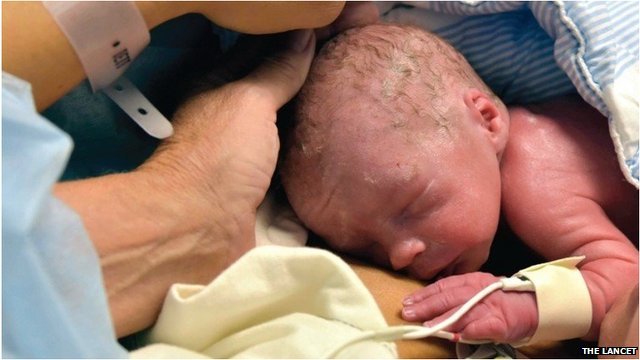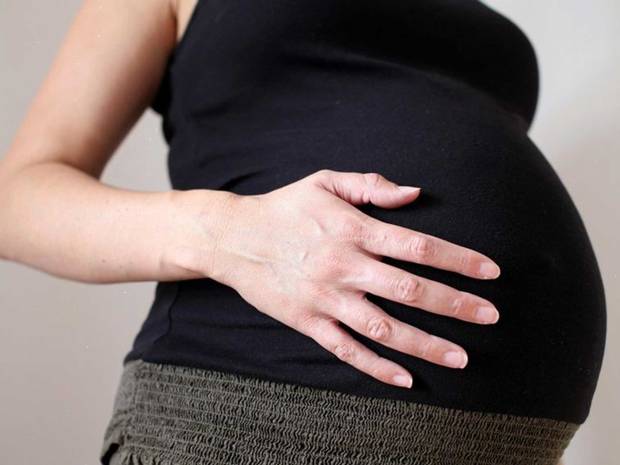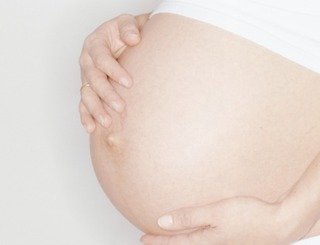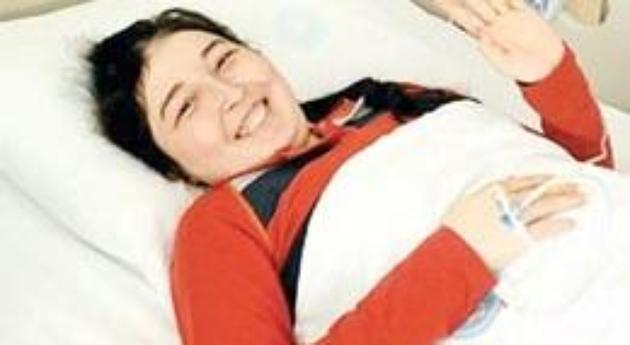Home Tags Posts tagged with "womb transplant"
womb transplant
The first picture of first baby to be born from a transplanted womb has been made public by his parents.
The baby boy’s birth took place in Sweden after surgeons at the University of Gothenburg performed the pioneering transplant procedure.
He was delivered by caesarean section in the 31st week of pregnancy and weighed 3.9 pounds – normal for that stage of pregnancy.
Both mother and child are now at home and said to be doing well.
The identity of the parents, a Swedish couple, has not been released, but the baby’s father said: “It was a pretty tough journey over the years, but we now have the most amazing baby.
“He is very, very cute, and he doesn’t even scream, he just murmurs.”
He added: “He’s no different from any other child, but he will have a good story to tell. One day he can look at the newspaper articles about how he was born and know that he was the first in the world to be born this way.”
The father spoke as the first picture of the baby was published, amid widespread excitement over a procedure which offers renewed hope to thousands of infertile women around the world.
The birth of the Swedish baby is understood to have taken place within the last month, after doctors transplanted wombs into several women who had a rare genetic condition that meant they were born without their own womb.
In January, one of the patients underwent IVF treatment that resulted in an embryo being transferred to her new womb. The donated womb came from a 61-year-old woman, a close family friend who had gone through menopause after giving birth to two children.
The 35-year-old mother is a patient of Dr. Mats Brannstrom, professor of obstetrics and gynaecology at the Sahlgrenska Academy in Gothenburg.
The mother had to take three medicines to prevent her body from rejecting the new organ. About six weeks after the transplant, she got her menstrual period – a sign the womb was healthy.

The baby boy’s birth took place in Sweden after surgeons at the University of Gothenburg performed the pioneering transplant procedure (photo Lancet)
After one year, when doctors were confident the womb was working well, they transferred a single embryo created in a lab dish using the woman’s eggs and her husband’s semen.
The woman, who has only one kidney, had three mild rejection episodes, including one during pregnancy, but all were successfully treated with medicines.
The baby’s growth and blood flow to the womb and umbilical cord were normal until the 31st week of pregnancy, when the mother developed preeclampsia, a dangerous high-blood-pressure condition.
After an abnormal fetal heart rate was detected, the baby was delivered by cesarean section.
Prof. Mats Brannstrom, who led the research and delivered the baby with the help of his wife, a midwife, said: “The baby is fantastic. But it is even better to see the joy in the parents and how happy he made them.
“That was a fantastic happiness for me and the whole team, but it was an unreal sensation also because we really could not believe we had reached this moment. Our success is based on more than 10 years of intensive animal research and surgical training by our team and opens up the possibility of treating many young females worldwide that suffer from uterine infertility.”
Liza Johannesson, a gynaecological surgeon on the team, said: “It gives hope to those women and men that thought they would never have a child, that thought they were out of hope.”
The Swedish couple, both competitive athletes, will have to decide shortly if they want a second baby.
The drugs used to prevent the womb being rejected would be damaging in the long term – so the couple will either try again or have the womb removed.
The father said: “We will definitely think about that. But right now, we’re very happy with just one baby.”
After the caesarean section, the womb would be left in place until the mother has completed her family and then removed so that drugs to stop the body rejecting the organ could be halted. The drugs carry an increased risk of cancer.
The operation, follow-up and immunosuppressant drugs cost $160,000, with the research paid for by the Jane and Dan Olsson Foundation for Science, a Swedish charity.
The only other options for women born without a womb were adoption or surrogacy if she wanted to have a child genetically related to her, but this is legally complicated.
Doctors around the world have welcomed the first successful birth from a transplant.
The first womb transplant was done in Saudi Arabia in 2000 but failed shortly afterwards.
In 2011 Derya Sert, 21, received a womb from a dead donor in Turkey. She conceived a child but no heartbeat was detected and it was later terminated.
In 2012 it was announced by Dr. Mats Brannstrom that nine womb transplants had been carried out and all were successful.
Eight of the recipients suffer from MRKH syndrome, a congenital disorder which affects one in 5,000 women and prevents the womb from developing.
The ninth had her womb removed after suffering cervical cancer.
The only other options for women born without a womb is adoption or surrogacy if she wants to have a child genetically related to her.
[youtube 59aBl1zWsAc 650]
A Swedish woman with a transplanted womb has given birth to a baby boy, in a medical first, doctors reported.
The 36 year-old mother, who was born without a uterus, received a donated womb from a friend in her 60s.
According to the medical journal The Lancet, the baby was born prematurely in September weighing 1.8kg (3.9lb). The father said his son was “amazing”.
Cancer treatment and birth defects are the main reasons women can be left without a functioning womb.
If they want a child of their own, their only option is surrogacy.
The identity of the couple in Sweden has not been released, but it is known the mother still had functioning ovaries.
The couple went through IVF to produce 11 embryos, which were frozen. Doctors at the University of Gothenburg then performed the womb transplant.

A Swedish woman with a transplanted womb has given birth to a baby boy, in a medical first
The donor was a 61-year-old family friend who had gone through the menopause seven years earlier.
Drugs to suppress the immune system were needed to prevent the womb being rejected.
A year after the transplant, doctors decided they were ready to implant one of the frozen embryos and a pregnancy ensued.
The baby was born prematurely, almost 32 weeks into the pregnancy, after the mother developed pre-eclampsia and the baby’s heart rate became abnormal.
Both baby and mum are now said to be doing well.
In an anonymous interview with the AP news agency, the father said: “It was a pretty tough journey over the years, but we now have the most amazing baby.
“He’s no different from any other child, but he will have a good story to tell.”
Two other medical teams have attempted womb transplants before.
In one case, the organ became diseased and had to be removed after three months. Another case resulted in miscarriages.
Prof. Mats Brannstrom, who led the transplant team, described the birth in Sweden as a joyous moment.
“That was a fantastic happiness for me and the whole team, but it was an unreal sensation also because we really could not believe we had reached this moment.
“Our success is based on more than 10 years of intensive animal research and surgical training by our team and opens up the possibility of treating many young females worldwide that suffer from uterine infertility.”
Liza Johannesson, a gynaecological surgeon in the team, said: “It gives hope to those women and men that thought they would never have a child, that thought they were out of hope.”
However, there are still doubts about the safety and effectiveness of the invasive procedure.
Dr. Mats Brannstrom and his team are working with another eight couples with a similar need. The results of those pregnancy attempts will give a better picture of whether this technique can be used more widely.
The couple, fresh from celebrating the birth of their child, will soon have to decide if they want a second.
The drugs used to prevent the womb being rejected would be damaging in the long term – so the couple will either try again or have the womb removed.
[youtube guPAvI3IsTk 650]
Nine Swedish women have received womb transplants from living relatives in a pioneering trial.
Dr. Mats Brannstrom, of the University of Gothenberg, who has been leading the experimental fertility project, hopes the technique could help other women who want to become pregnant.
This includes women either born without a womb or who have womb problems that stop them conceiving.
Dr. Mats Brannstrom’s team recruited 10 women to their trial. One could not proceed with the trial for medical reasons, but nine went on to have a womb transplant.
These women were born without a uterus or had it removed because of cervical cancer.
Most are in their 30s and are part of the first major experiment to test whether it is possible to transplant wombs into women so they can give birth to their own children.

Nine Swedish women have received womb transplants from living relatives in a pioneering trial
There have been two previous attempts to transplant a womb – in Turkey and Saudi Arabia – but both failed to produce babies.
“This is a new kind of surgery,” Dr. Mats Brannstrom told Associated Press in an interview from Gothenburg.
“We have no textbook to look at.”
Dr. Mats Brannstrom and colleagues will run the first workshop on how to perform womb transplants and they plan to publish a scientific report on their efforts soon.
The transplant operations did not connect the women’s uteruses to their fallopian tubes, so they are unable to become pregnant naturally. But all who received a womb have their own ovaries and can produce eggs to be used for IVF treatment.
Derya Sert, a woman who had the world’s first successful womb transplant, is set to undergo IVF in a bid to fulfill her dream of motherhood.
Speaking in London last week, her surgeon Professor Omer Ozkan revealed that the married housewife has responded so well to treatment that his medical team is confident the first “donor womb” pregnancy is now possible.
But some British experts, including Lord Winston, claim that a pregnancy could cause potentially fatal complications. And the baby would have to be born by caesarean, which carries the risks of surgery.
Prof. Omer Ozkan, who performed the pioneering transplant on 22-year-old Derya Sert in August last year, announced her IVF treatment at a conference attended by the world’s top transplant specialists. The event was organized by Richard Smith, a consultant at Imperial College London who could be ready to perform similar operations on British women in just two years.
Prof. Omer Ozkan, from Akdeniz University in Antalya, Turkey, also revealed three more women are to undergo transplants at his clinic, providing Derya Sert has a healthy baby.
He said: “This is the longest time any woman has gone without rejecting an implanted womb and we wanted to reach the year-and-a-half mark before going ahead. That will hopefully happen in three months’ time as things are looking good so far.”
Prof. Omer Ozkan described Derya Sert’s health as “absolutely normal”, adding: “It’s not only important for us to have this contact for the patient, it’s also important for future cases.”
Derya Sert, who is married to 35-year-old Mustafa, has said: “If I had a magic wand, I would want to be pregnant now. I just want to hold my baby in my arms, to be a mother.”

Derya Sert, who had the world’s first successful womb transplant, is set to undergo IVF in a bid to fulfill her dream of motherhood
Prof. Omer Ozkan and his team will take two out of eight embryos frozen before Derya Sert’s treatment, thaw them and transfer them into her uterus. The hope is this will lead to at least one baby – or even twins.
Women who have lost their wombs to cancer need to have been free of the disease for at least five years before they can be considered for a transplant.
But womb transplants have been criticized by experts because they are not carried out to “save a life”.
Risks include rejection of the new womb and potential side effects during pregnancy from the powerful anti-rejection drugs.
After the first womb transplant, carried out in Saudi Arabia in 2000, the donated organ “failed” after three months because the blood vessels used to connect it were too narrow and became blocked by clots.
However, Prof. Omer Ozkan does not doubt womb transplants are worth the risks for thousands of women otherwise unable to have a “normal” pregnancy.
He said: “Many people think that womb transplants aren’t necessary because they’re not lifesaving operations and that women have the option of adoption or surrogacy.
“But we’ve had applications from women all over the world wanting womb transplants. This is absolutely necessary for these women: you just have to ask them to realize this.”
A total of 100 women have now been screened by Prof. Omer Ozkan in addition to Derya Sert, who received her healthy organ from a car-crash victim. Ten of these have been selected as possible recipients. Of these, three have been approved for a transplant and have undergone fertility treatment. This has resulted in viable embryos, which have been put on ice.
Prof. Omer Ozkan could now have a race on his hands to become the first doctor to achieve a successful pregnancy from a womb transplant.
Swedish experts carried out two procedures in September, both involving the world’s first mother-to-daughter uterus transplants.
This week, they announced another two operations – a mother-to-daughter and an aunt-to-niece – with more transplants scheduled for early 2013. All involve live transplants, whereas Prof. Omer Ozkan’s Turkish team used wombs from dead donors.
The scientists and doctors at the University of Gothenburg have received approval to complete ten procedures in total. The remaining six procedures, scheduled for next year, include a woman donating to her son’s wife and another giving her womb to her younger sister.
The next step is to begin embryo implantation at the end of 2013.
Doctors are divided over whether to use living or dead donors. Some experts are uncomfortable with taking the womb from a living woman when it is not for life-saving reasons. With live transplants, there are risks to two living patients. However, an organ from a living donor can be a better match.
Two Swedish women could be able to give birth using the wombs in which they were carried, doctors say, hailing the world’s first mother-to-daughter uterus transplants.
The weekend procedures were completed by more than 10 surgeons at Sweden’s University of Gothenburg.
The names of the patients have not been revealed.
Doctors caution they will not consider the operations successful unless the women achieve pregnancy.

Two Swedish women could be able to give birth using the wombs in which they were carried
“We are not going to call it a complete success until this results in children,” said Michael Olausson, one of the Swedish surgeons told The Associated Press.
“That’s the best proof.”
Both women started in-vitro fertilization before the surgery, he said, adding that their frozen embryos will be thawed and transferred if the women are considered in good enough health after a year-long observation period.
Both recipients, who are aged in their 30s, were tired after the surgery but recovering well, said the university in a statement.
One had her uterus removed due to cervical cancer and the other was born without a uterus, they added
“The donating mothers are up and walking and will be discharged from the hospital within a few days,” said Mats Brannstrom, a professor of obstetrics and gynaecology at the university.
He is the leader of a research team – comprising 20 scientists, doctors and specialists – which has been working on the project since 1999.
Turkish doctors said they had performed a successful uterus transplant last year, giving a womb from a deceased donor to a young woman, but Dr. Michael Olausson said he was not sure whether the recipient had yet started undergoing fertility treatment.
The first widely reported womb transplant from a live donor was performed in 2000, in Saudi Arabia, but the organ had to be removed three months later because of a blood clot.
Last year, 56-year-old Eva Ottoson, who lives in Nottinghamshire, said she hoped to become the first woman to have her womb transplanted into her daughter, Sara, 25, who lives in Sweden and was born without reproductive organs.
It remains unknown whether they were involved in the weekend’s procedures.
Turkish doctors have carried out the world’s first successful womb transplant in a breakthrough that could allow thousands of young women to fulfill their dream of motherhood.
Derya Sert, a young Turkish woman who was born without a womb, received a healthy organ in a seven-hour operation.
Scans show her new womb, which came from a woman who had died in a car crash, to be healthy and working well.
Derya Sert, 22, is due to start IVF treatment in Turkey in September in the hope of conceiving a longed-for child.
She said: “People ask me now if I want a boy or a girl, but it doesn’t make any difference to me, I just want a child a healthy baby.
“If I had a magic wand, I would want to be pregnant now. I just want to hold my baby in my arms, to be a mother.”
Her surgeon, who believes womb transplants will become common in the future, said that some women’s desire to be pregnant is so overwhelming that they would take any risk – even death – to have a child.
Risks range from rejection of the new womb, to potentially fatal complications of pregnancy. Any baby will have to be delivered by caesarean section and the drugs needed to prevent the womb being rejected can raise the risk of cancer and trigger illnesses such as diabetes.

Derya Sert, the first woman in the world who received a womb from a cadaver in a seven-hour operation
Womb transplants have been carried out successfully in animals including mice, rats and sheep, who then went on to have offspring.
The operation has been done on a woman once before, in Saudi Arabia in 2000.
But the donated womb, taken from a living donor, withered after three months because the blood vessels used to connect it were too narrow and became blocked by clots.
In August last year, Derya Sert became the first woman in the world to receive a womb from a dead donor.
Using a dead donor allowed her doctors at Akdeniz University Hospital in the Turkish city of Antalya to remove the extra tissue and large blood vessels needed to give the womb a reliable blood supply.
Like one in every 5,000 women, Derya Sert, a housewife married to a car mechanic, was born without a womb. She had never had periods, but her ovaries were healthy and she could produce eggs.
Raised in Anamur, a traditional, conservative town in the country’s southern tip, the farmer’s daughter found it difficult to come to terms with the fact that she would never become pregnant and appealed to doctors for help.
The operation involved leading plastic surgeon Omer Ozkan, seven other doctors and another seven medical staff.
Derya Sert spent six months in hospital and was given powerful immunosuppressant drugs to stop her body rejecting the new womb.
Her periods started three weeks after the operation, a signal that the new womb is working well. Scans show its lining to be healthy. The true test of success will come in September, when up to two of the eight embryos created from Derya Sert’s eggs and her husband’s sperm, and frozen ahead of the transplant, will be inserted into her womb.
Derya Sert said: “We could be so happy if I could be a hope for other women. I wish for them to have the baby they long for.”
Her husband Mustafa, 35, said: “If the baby is a boy, we will name him after our doctor.”
Dr. Omer Ozkan, who has just carried out a full face transplant, has been contacted by women from all over the world desperate to have womb transplants.
But he does not plan to do another of the operations until he has seen if Derya Sert is able to have a healthy baby.
Dr. Omer Ozkan said: “This is the first successful womb transplant but the most difficult stage still lies ahead – learning if the patient can become pregnant and have a baby.”
In Sweden, surgeons at the University of Gothenburg have been given the go-ahead to carry out living transplants in which a mother gives her womb to her daughter.
In UK, Richard Smith, a consultant gynaecological surgeon at Imperial College London, could be ready to operate on British women, using wombs from dead donors, in two to three years. More than 50 potential patients have already come forward.






